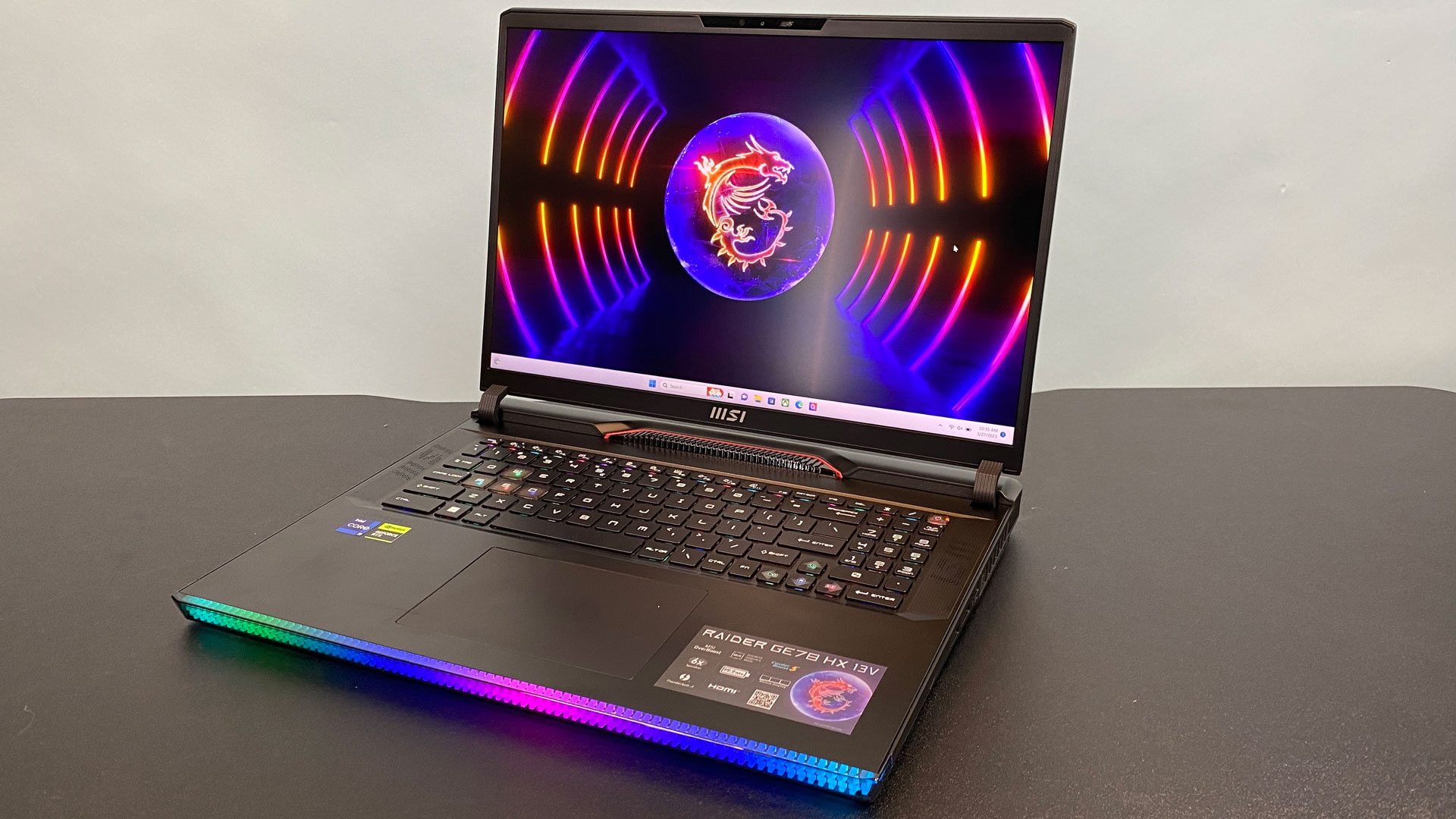
Gaming laptops are getting tall. This year, an increasing number of the best gaming laptops have moved to loftier screens with 16:10 aspect ratios, showing more of your games and work than ever before. The MSI Raider GE78 HX ($2,999.99 as tested) has been redesigned around this new screen size, with a race car-inspired look, funky RGB light bar and room for both an Intel Core i9-13950HX and Nvidia GeForce RTX 4080 Laptop GPU.
The redesign gets a lot right. The system performs well and has a colorful display. The keyboard, while set back further than I'd like, is comfortable to type on. And there areplenty of ports on the system for work and play alike.
Those who regularly upgrade their PCs might want to consider the surprising difficulty of getting the base off of the system (though it is definitely possible, and there are plenty of repair opportunities when you're in there).But you may want to get a pair of headphones to block out the fan noise.
Design of the MSI Raider GE78HX
The GE78HX Raider is embracing its identity as a gaming machine. For the last couple of years, MSI's Raiders were restrained in their design (or at least as restrained as you can be with an RGB light bar), using a silvery-blue finish that could almost fool you into thinking the laptop wasn't designed to help you take down opponents in first-person shooters. But this year, the Raider looks like its more expensive sibling, the Titan, with a red-striped racecar detail and a shiny black aluminum lid with an RGB dragon shield. Yep, we're back to gaming PCs looking like they're meant for teens.

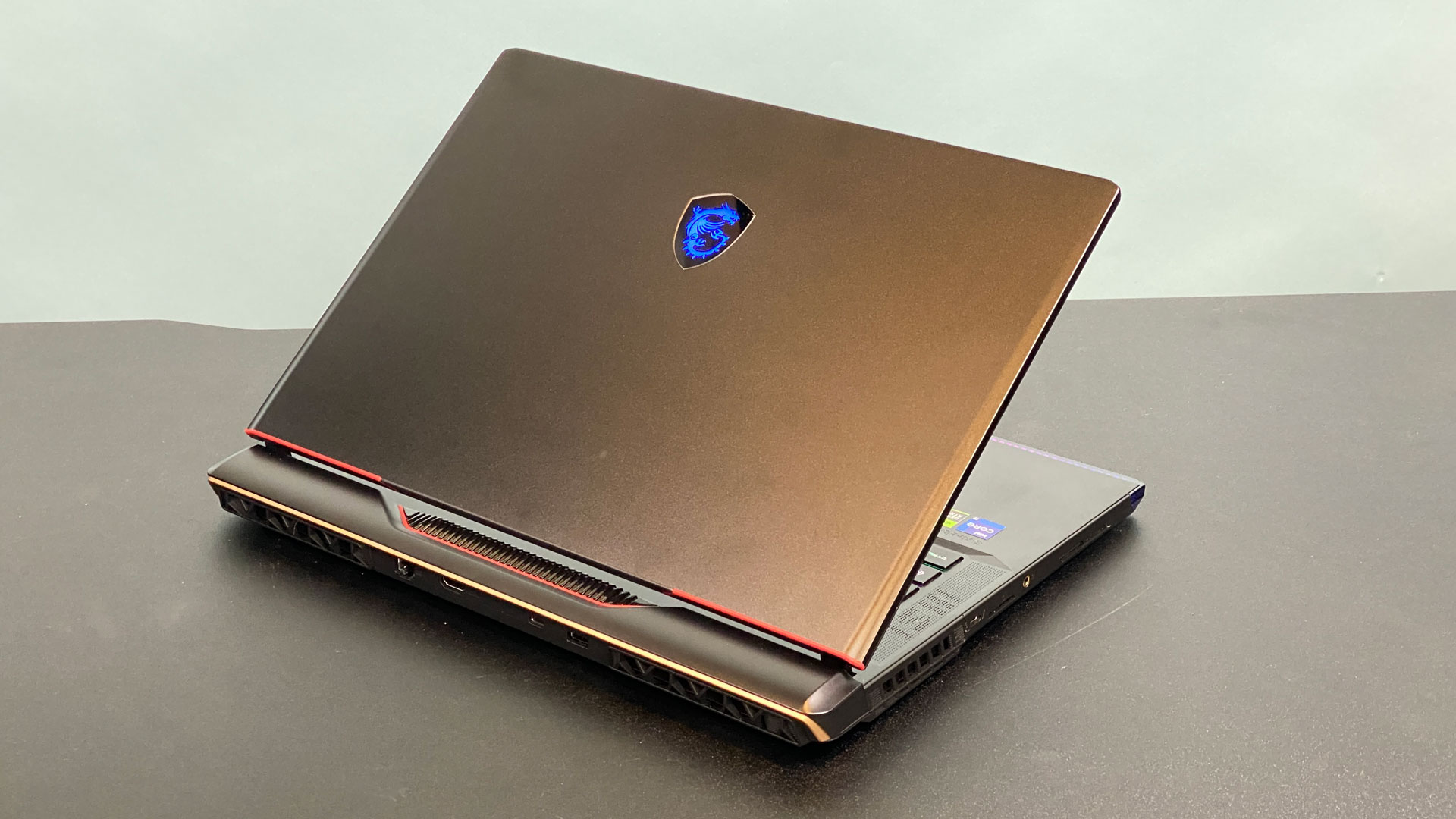
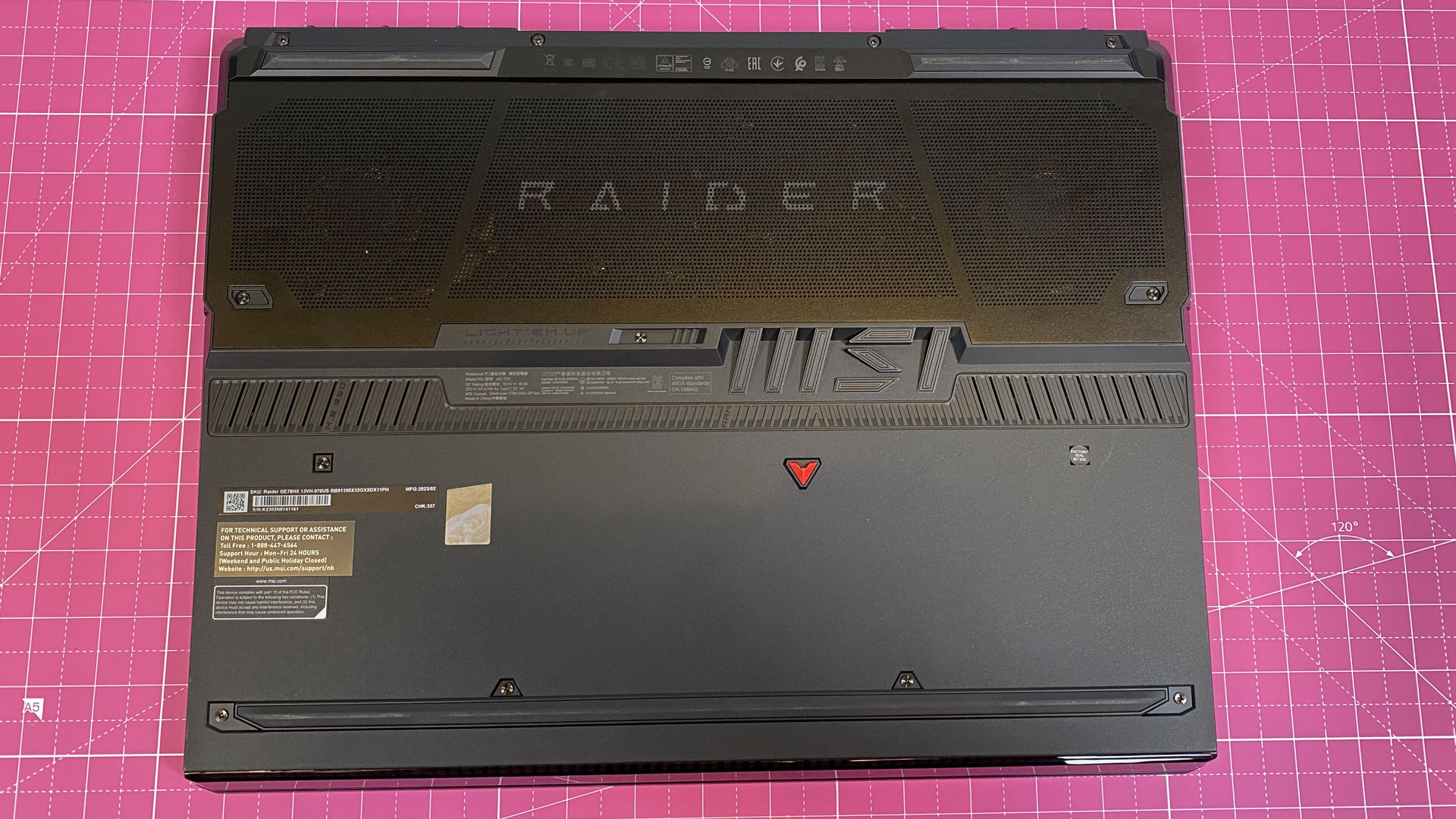
MSI's signature here is a lightbar on the underside of the front of the system. While previous light bars have diffused the individual LEDs into one amorphous blob of light, this time the design looks like a bunch of tiny square bubs. It's just as colorful, but it's also kind of retro, like something you might find on a jukebox. As far as RGB goes, this is at least unique.
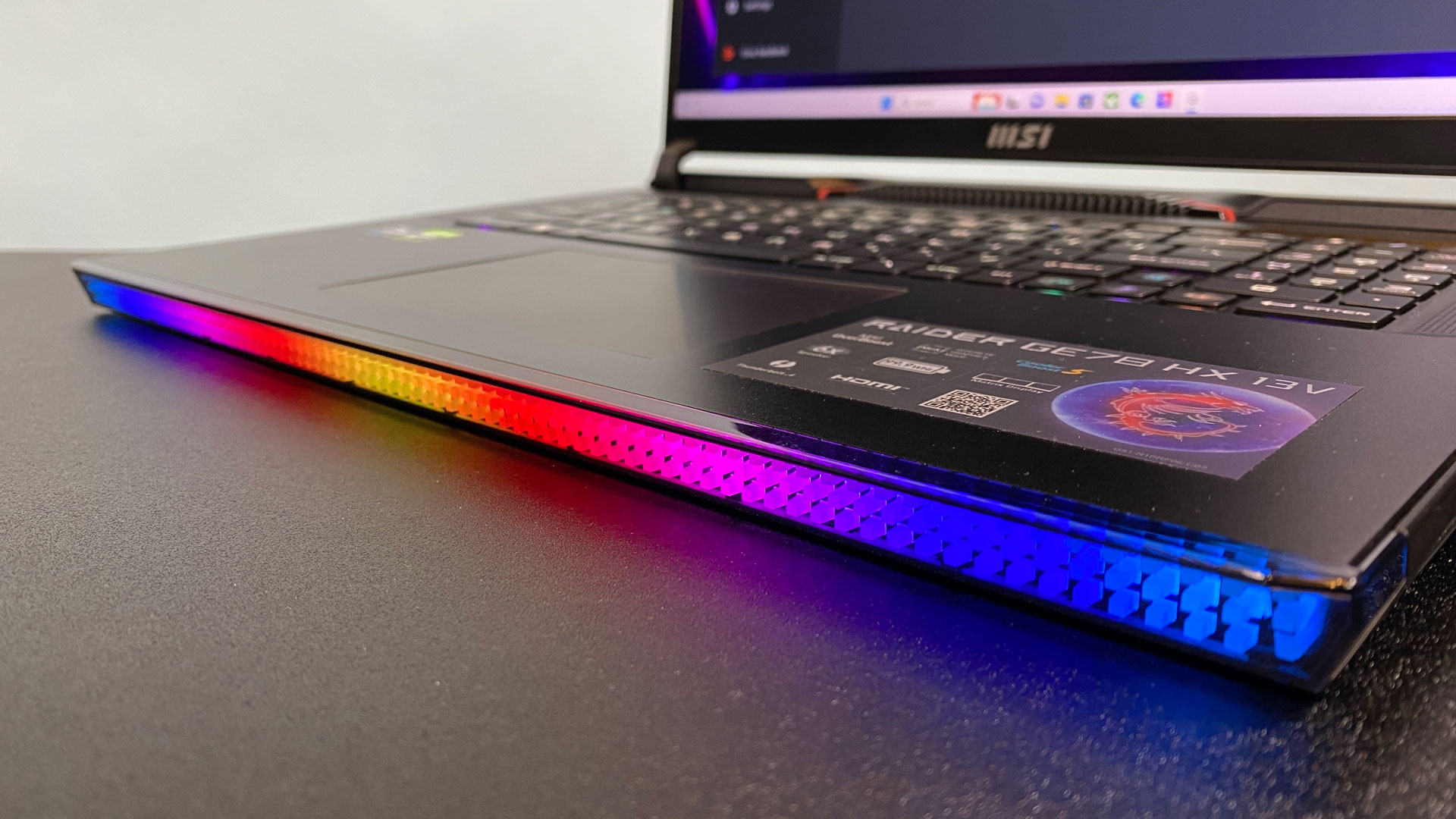
The 17-inch, 2560 x 1600 display is flanked by minimal bezels, though the top has a bit of extra chunk to fit the 1080p webcam with a privacy shutter.
There are ports dispersed across both sides and the back of the laptop. The left side has a Thunderbolt 4 port, an SD card slot and a 3.5 mm headphone jack. The right side has a pair of USB 3.2 Gen 2 Type-A ports, and a USB 3.2 Gen 2 Type-C port. In the back, there's an Ethernet port, HDMI 2.1, another USB Type-C port, and the power jack (which is shaped a bit like a USB-A port), but is not.
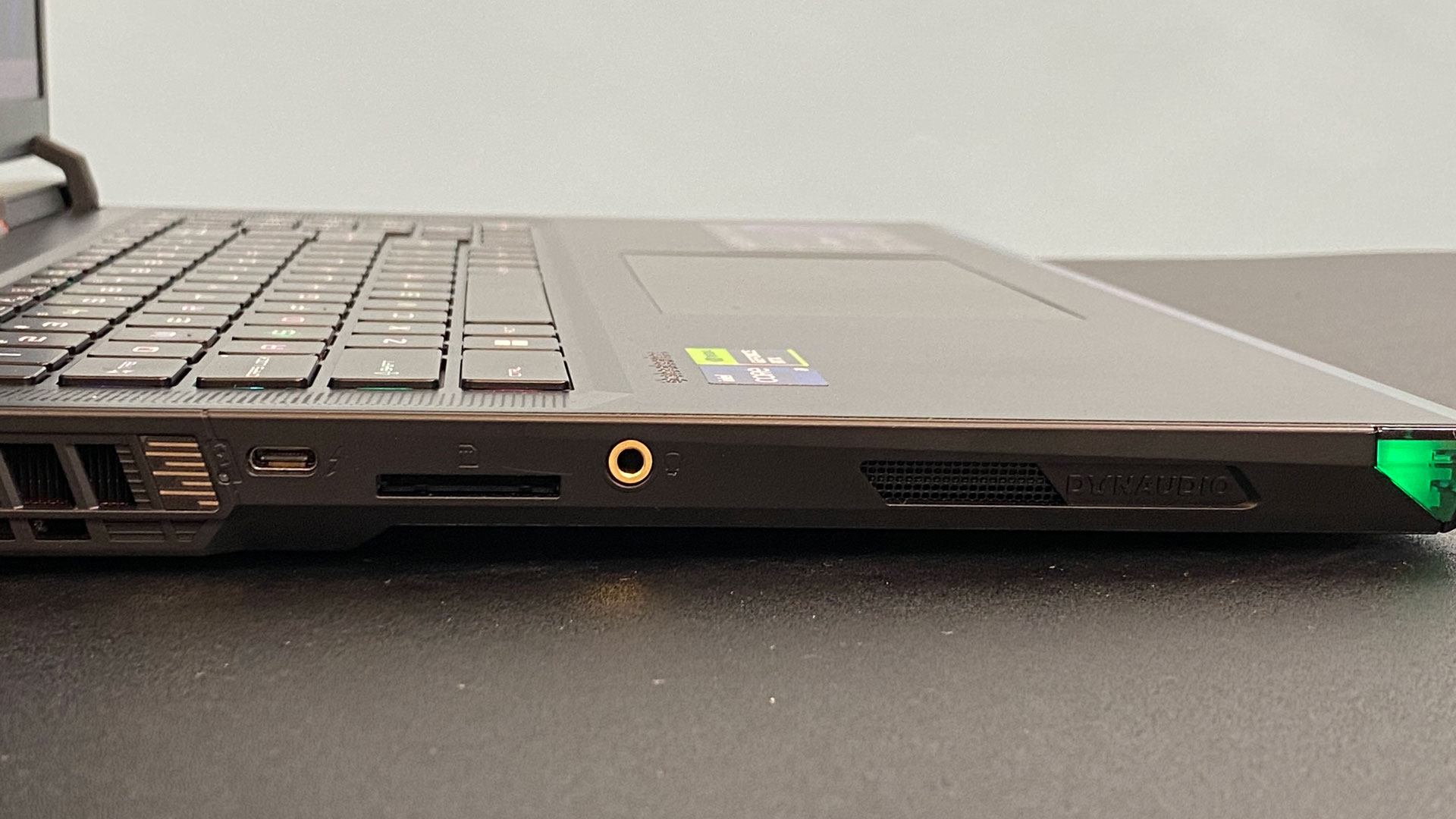
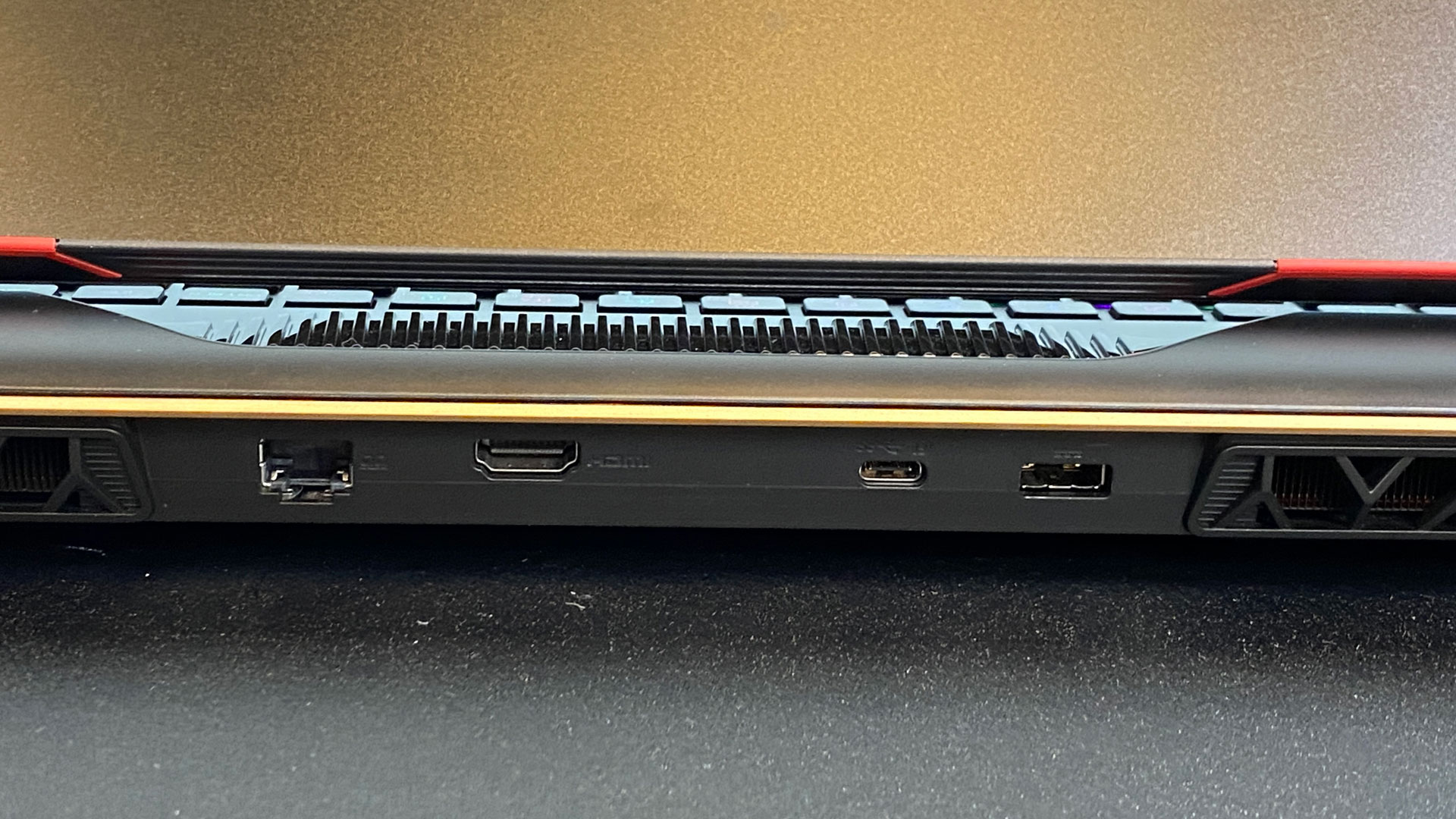
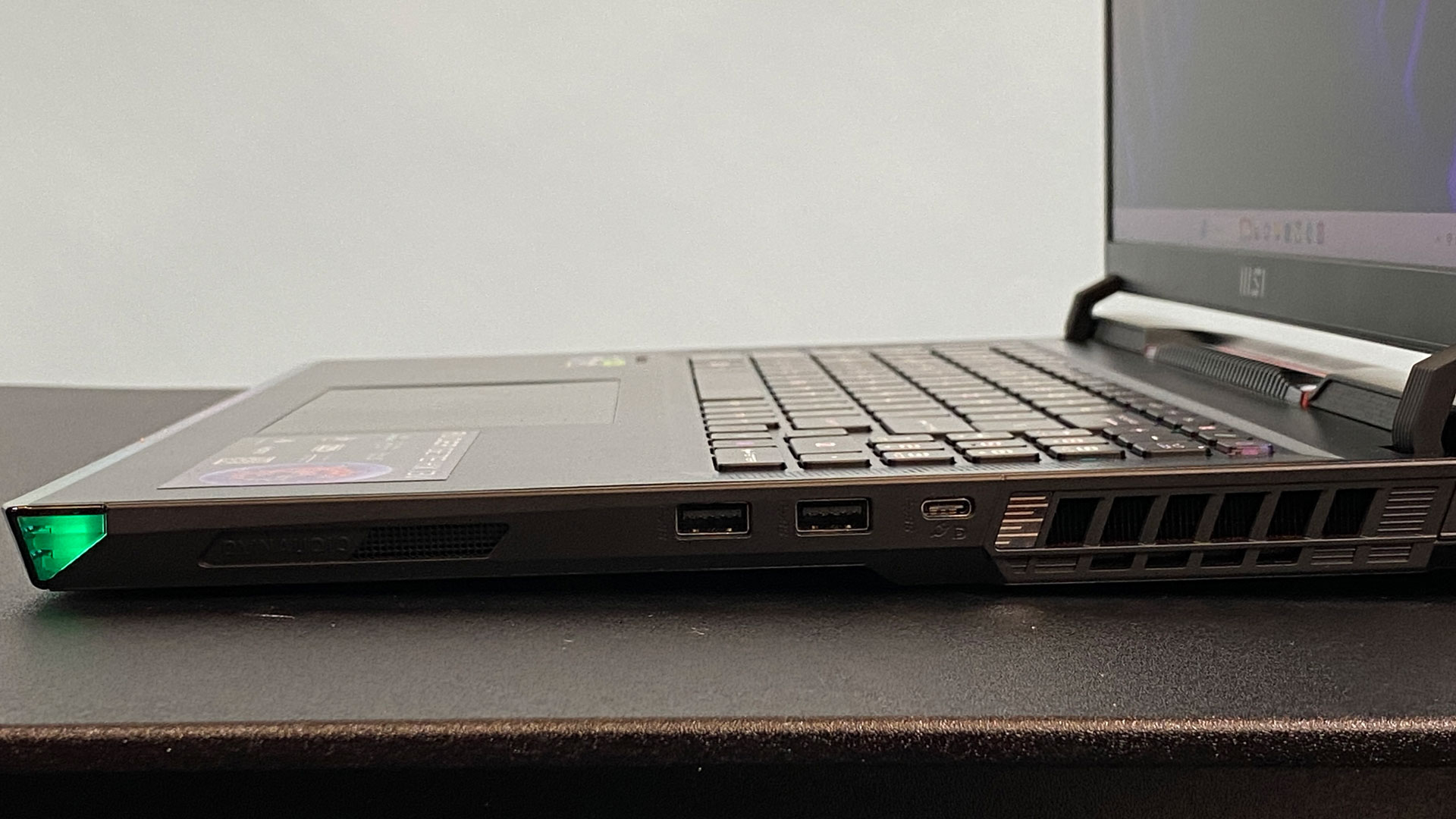
MSI's new Raider is 6.83 pounds and measures 14.97 x 11.73 x 1.13 inches. It just fit into my backpack — the mix of a taller screen and the ports on a bump on the back made it a squeeze. But it's far more portable than MSI's deskbound Titan GT77 HX, which is 7.28 pounds and 16.63 x 12.99 x 0.91 inches. If you want something a bit smaller, the Gigabyte Aorus 15X is 14.1 x 10.8 x 0.78 inches and 5.79 pounds, while the Asus ROG Strix G16 is 13.94 x 10.39 x 0.89 inches and 5.51 pounds
MSI Raider GE78 HX Specifications
Gaming and Graphics on the MSI Raider GE78 HX
The Raider is one of the first systems we've seen with an Nvidia GeForce RTX 4080 Laptop GPU, which, paired with an Intel Core i9-13950HX, proved to be powerful in gaming tests.
I used MSI's laptop to play Deathloop, which worked well at the native 2560 x 1600. On very high settings, it ran between 87 and 94 fps as Colt pursued Egor through Array Y.
The Raider often came close behind its larger sibling, the Titan with an RTX 4090, and advanced ahead of its the Gigabyte Aorus and Asus ROG Strix (both toting RTX 4070 GPUs) in 1080p. Native resolution comparisons were more complicated though, as these laptops stretched across various resolutions and aspect ratios.
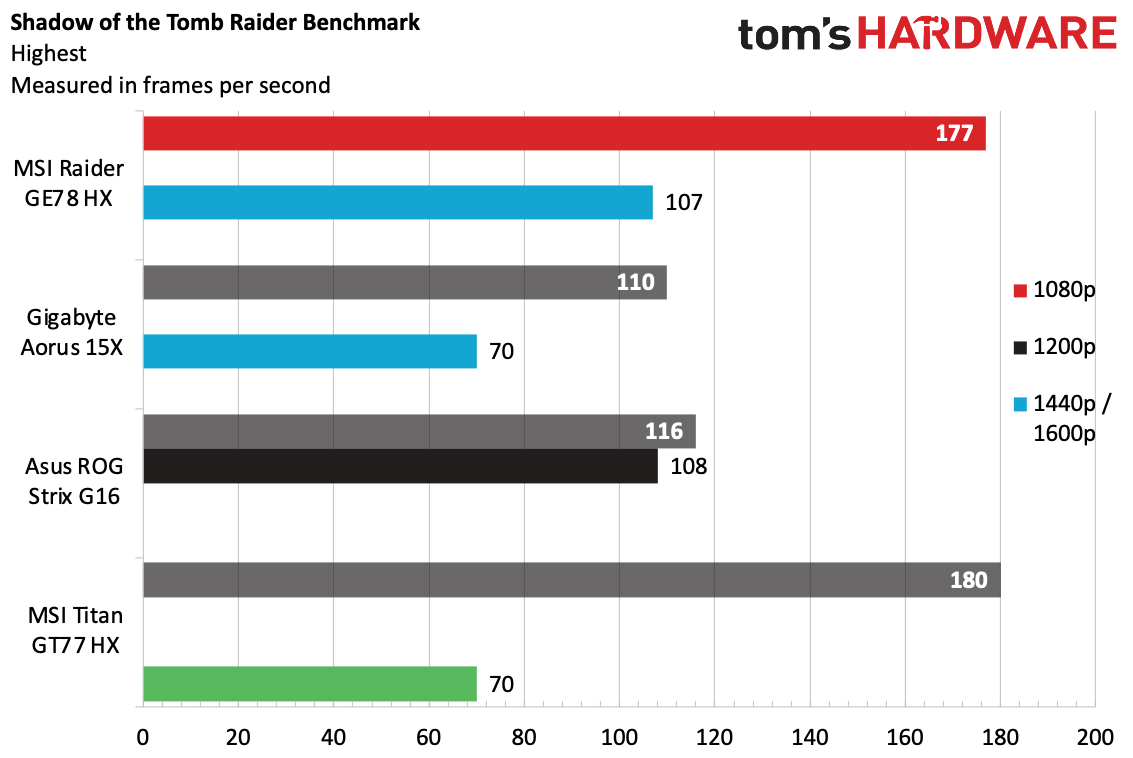
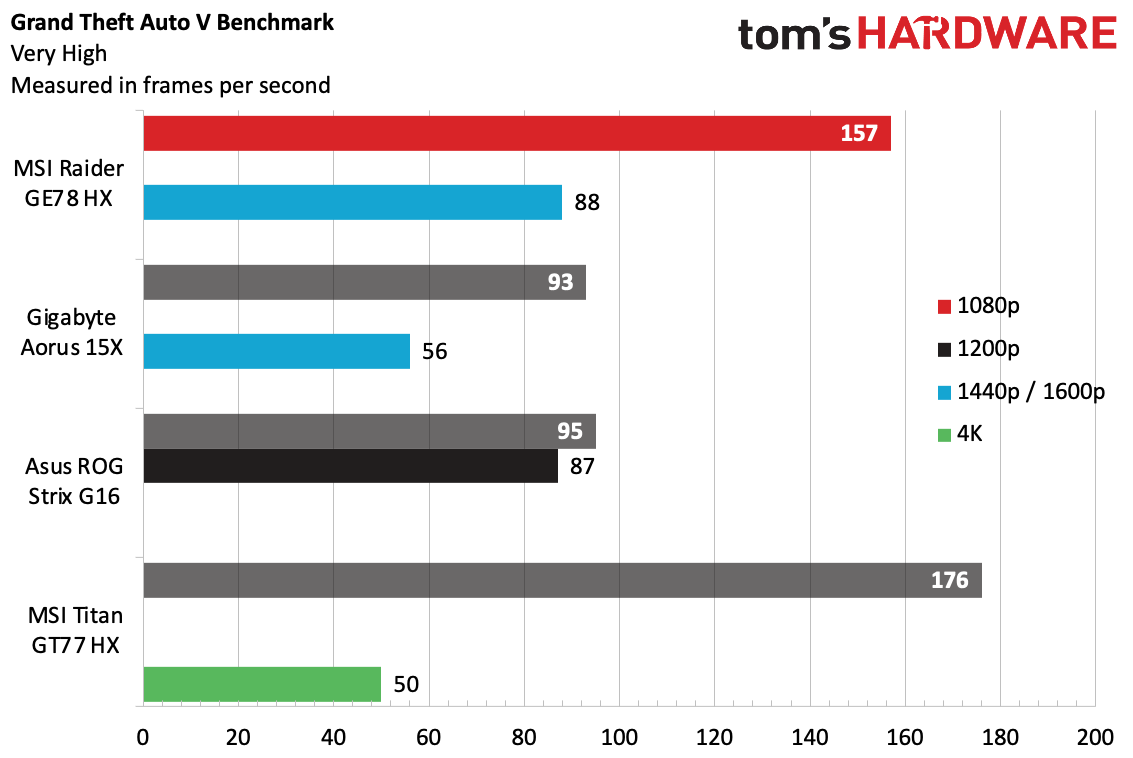
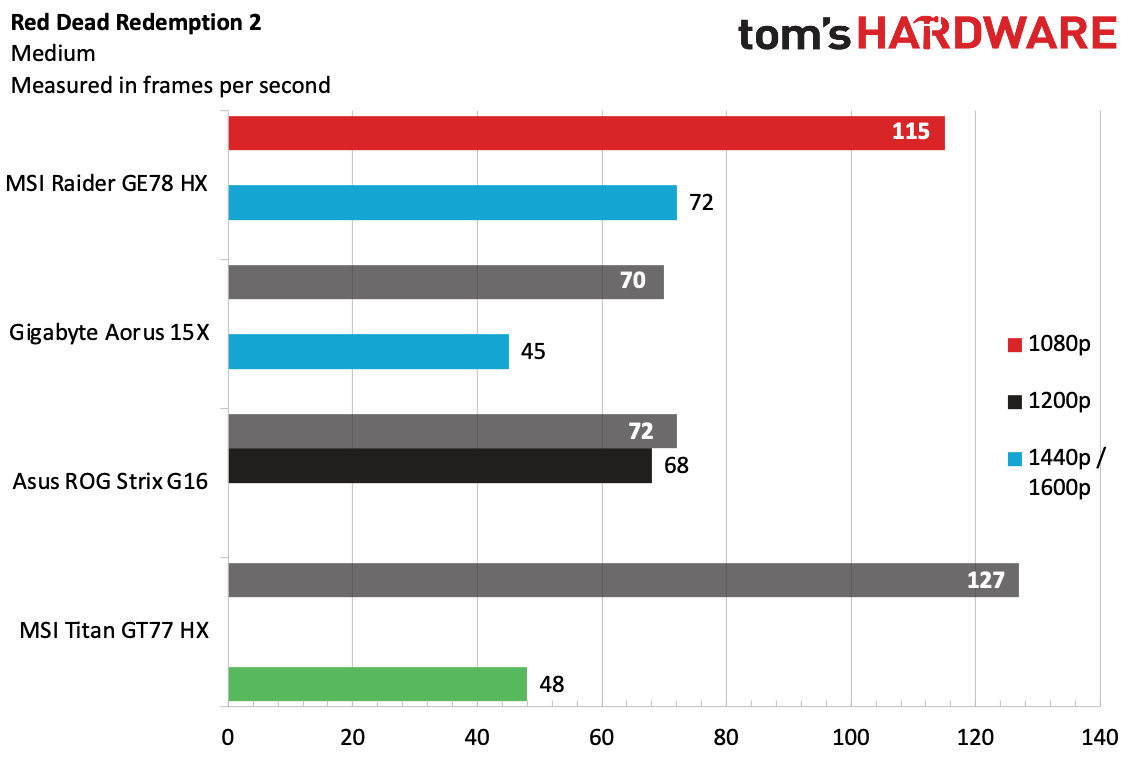
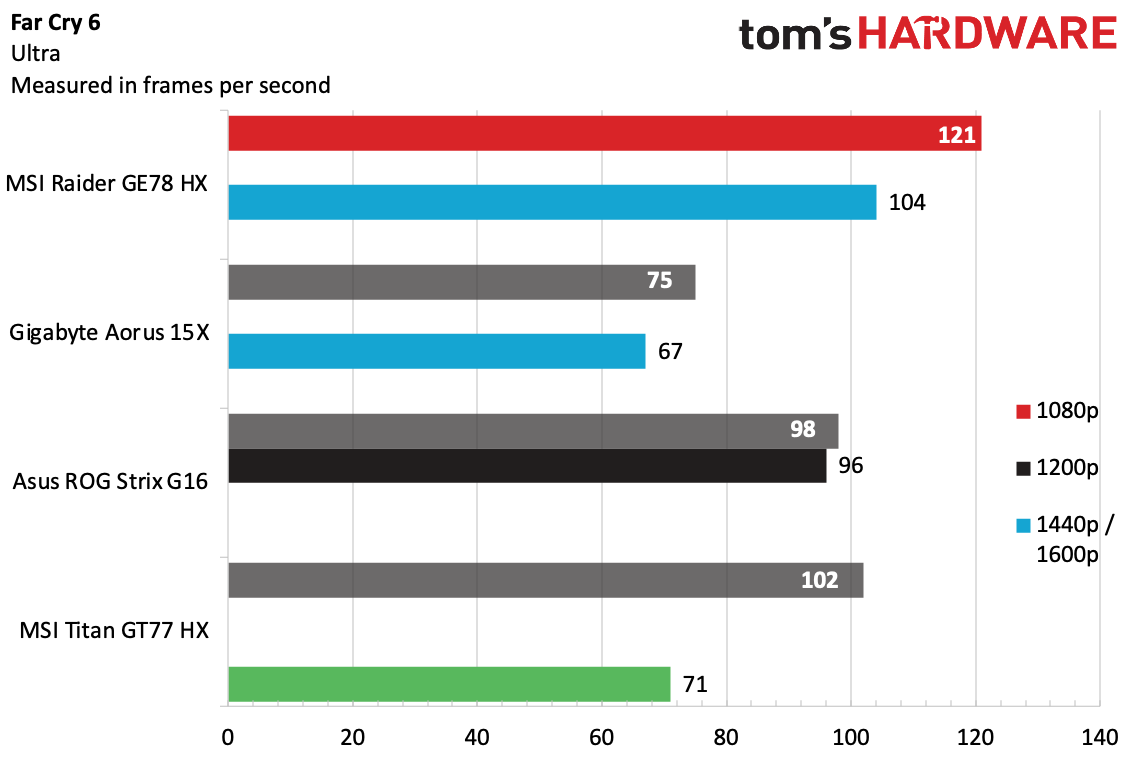
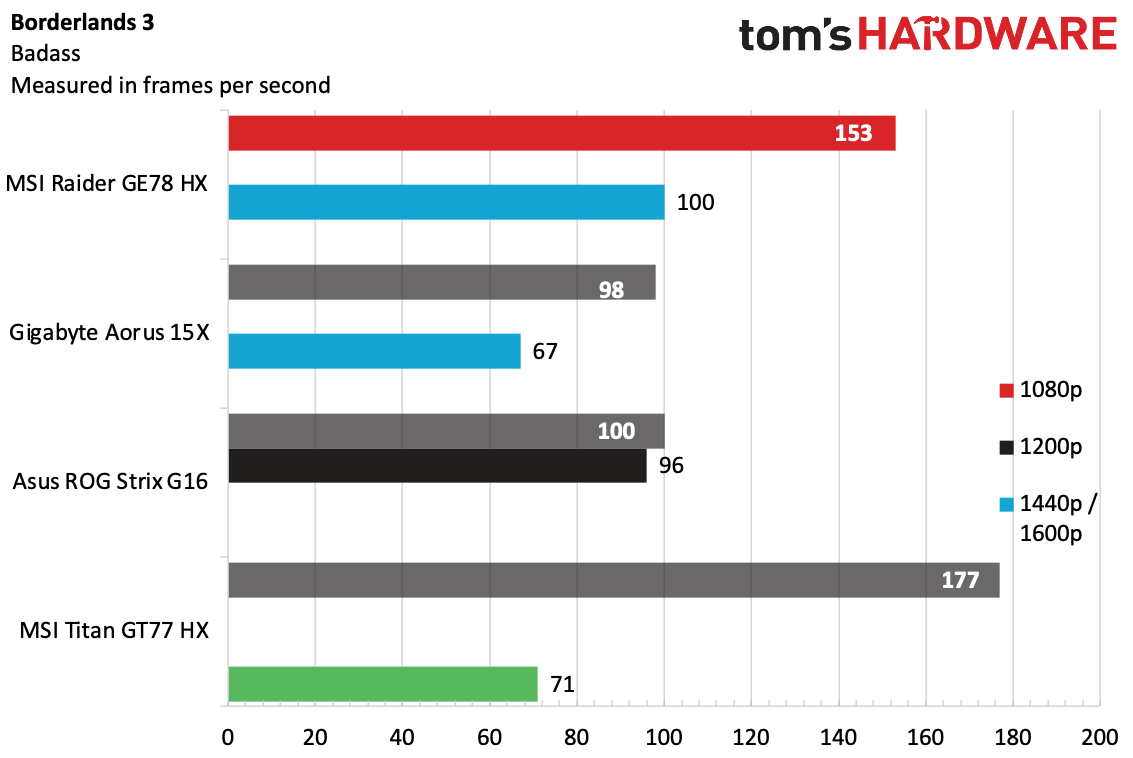
MSI's new Raider came in reliably behind the more powerful Titan in 1080p on Shadow of the Tomb Raider (177 fps), Grand Theft Auto V (157 fps), and Red Dead Redemption 2 (115 fps) and Borderlands 3 (153 fps). It did outperform on Far Cry 6, at 121 fps, though that game is notoriously CPU-reliant.
At its native 1600p, the RTX 4080 in the Raider beat the RTX 4070 pushing a lower 1440p in all of our gaming tests. In games with DLSS support, such as Shadow of the Tomb Raider, Red Dead Redemption 2 and Metro Exodus, quality mode upscaling can generally improve performance by 30–50 percent, sometimes more, and the resulting image quality often competes well against native rendering. DLSS 3 Frame Generation, where supported, can artificially boost the rate of frames sent to your display by 50–100%, but it causes additional latency and the actual feel of games with DLSS 3 doesn't improve nearly as much as the higher FPS would indicate. It's not a bad option to have, but personal preference becomes a real factor in what Frame Generation does to the overall experience.
To stress test laptops, we run the Metro Exodus benchmark on the RTX preset for 15 runs, simulating half an hour of gameplay. During the stress test, the Raider ran the game at an average of 75.37 fps (and was typically within two frames of that frame rate.) The CPU ran at an average of 2.85 GHz on the performance cores and 2.21 GHz on the efficient cores; the CPU package measured 53.09 degrees Celsius. The GPU ran at 1,190.38 MHz and measured 44.56 degrees Celsius.
Productivity Performance on the MSI Raider GE78 HX
The Raider, with an Intel Core i9-13950HX, 32GB of DDR5 RAM and 2TB of storage, has the makings of a monster productivity machine.
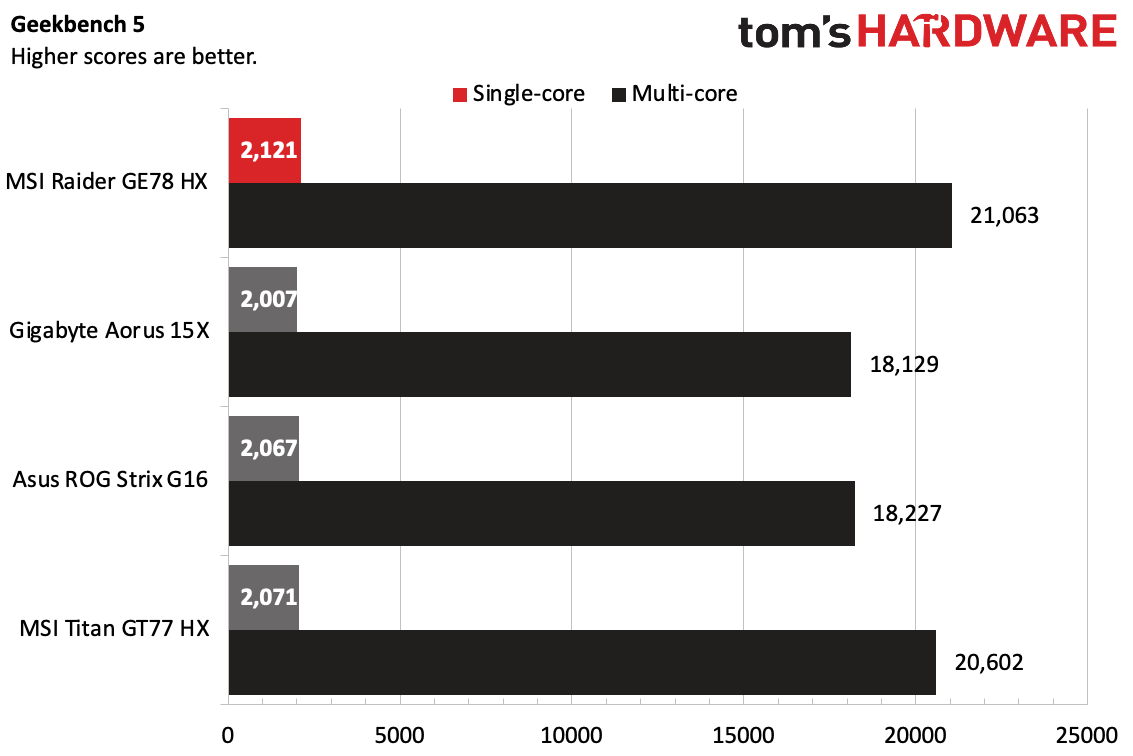
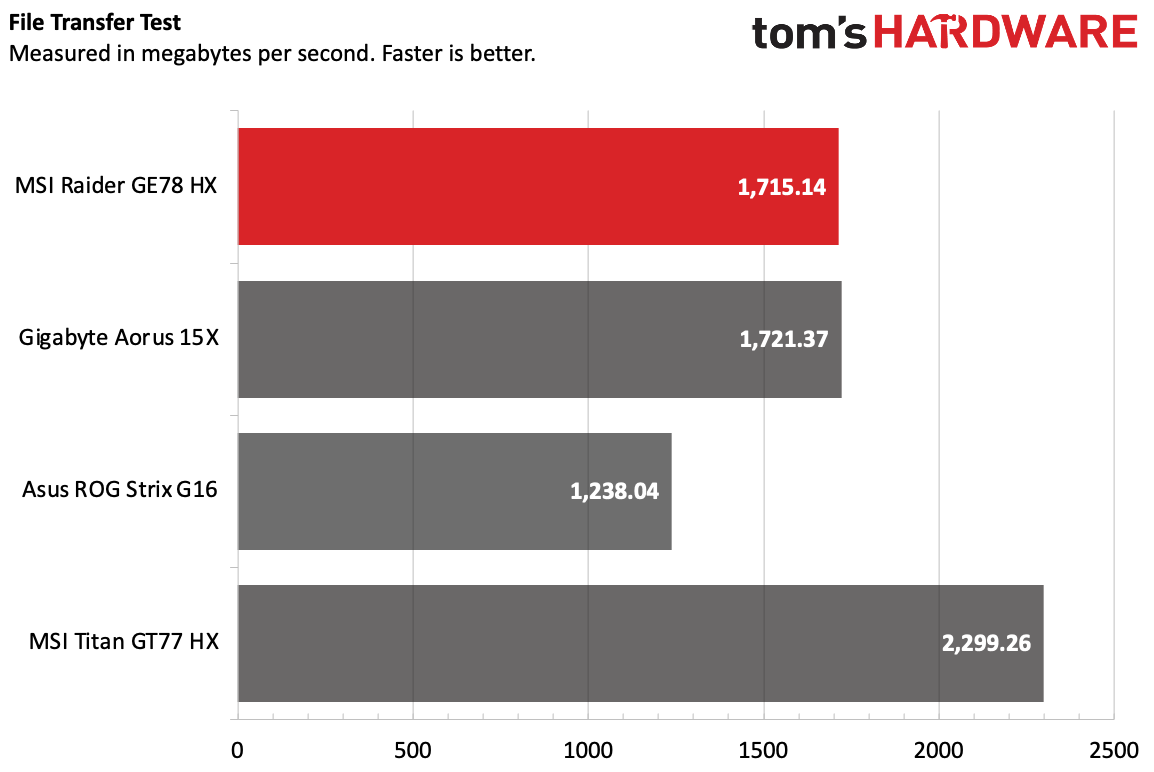
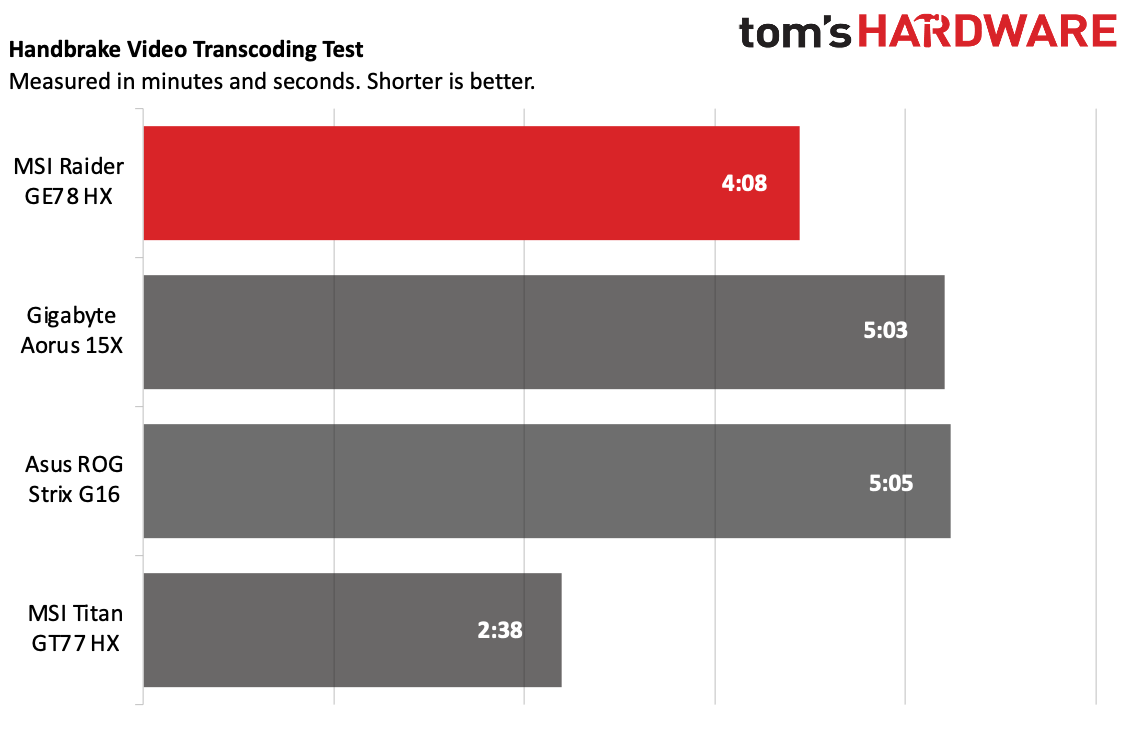
On Geekbench 5, the Raider reached a single-core score of 2,121 and a multi-core score of 21,063. Interestingly, in single-core, it was beaten only by the Aorus 15X (Core i9-13900HX) at 2,705. The Raider took the top score on multi-core among the systems, including the Strix G16 with Core i9-13980HX boasting ever-so-slightly higher boost clocks.
All of the laptops were quick at copying 25GB of files in our file transfer test. The Raider copied the files at 1,715.14 MBps, just in range of the Gigabyte but slower than the Titan (2,299.26 MBps). The Strix was the slowest here, but still serviceable.
The Raider completed our Handbrake video editing test in 4 minutes and 8 seconds, beating both of its smaller rivals. It was smoked, however, by the Titan, which completed the same task in 2:38.
Display on the MSI Raider GE78 HX
MSI's display is impressive. It's bright and colorful, with a 17-inch diagonal and a 2560 x 1600 resolution at up to 240 Hz. The 16:10 aspect ratio is new for the Raider, and allows for a taller screen, which I typically associate with being useful for productivity work more than gaming. That said, the RTX 4080 can likely push the extra pixels above 16:9.
When I played Deathloop, a sunset over Array Y cast a lovely golden glow over the level's wheatgrass fields. Shadows and reflections looked great, though in some dark levels I wished I could turn the brightness up slightly.
I used the Raider to stream the trailer for Power Rangers: Once & Always so that I could feel like it's the '90s again. The colors were excellent, and every ranger suit was exactly as I remembered it when I was in grade school. In some darker scenes in the Command Center, it would've been nice to make it slightly brighter, but it wasn't a major issue. (None of this can fix the trailer's bad CGI, but then again, I suppose that's loyal to the source material.)
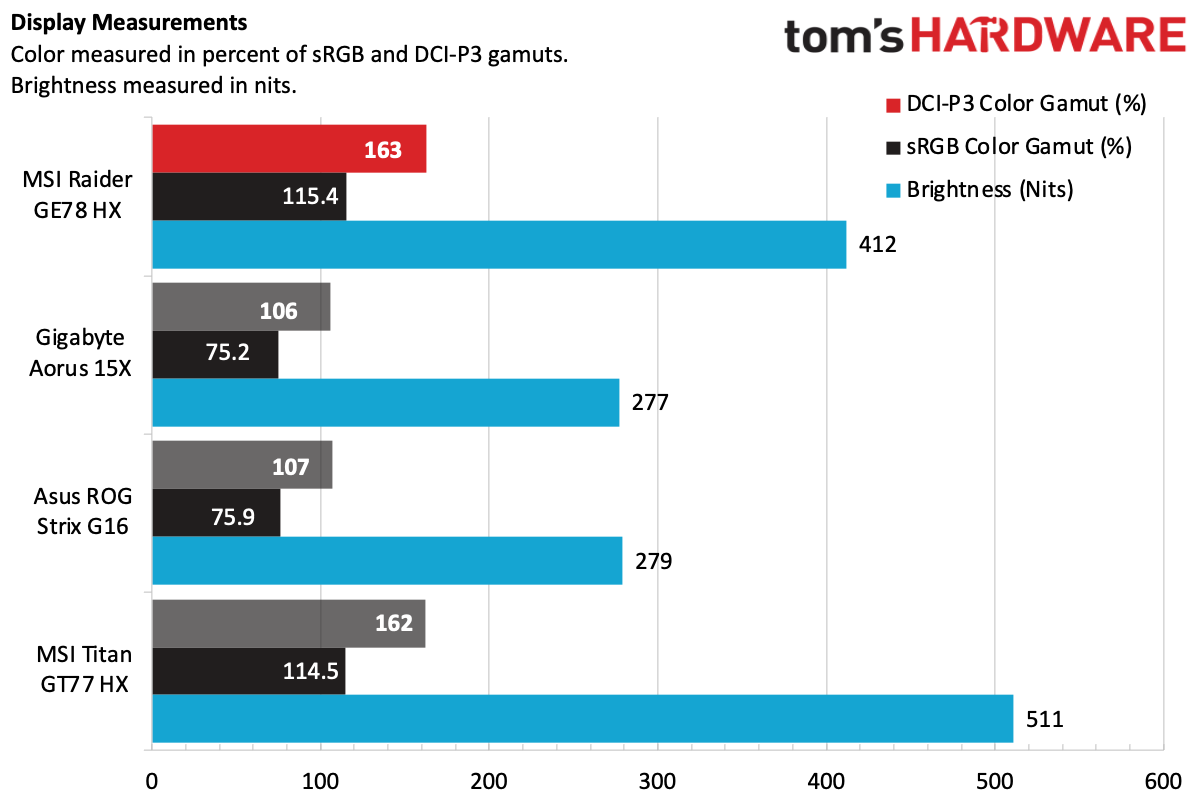
The Raider's 2560 x 1600 panel covered 163% of the sRGB gamut and 115.4% of the DCI-P3 color gamut. That puts it on par with the Titan's Mini LED panel. But the Titan is way brighter, at 511 nits to the Raider's 412 nits, which makes a difference.
The Aorus and Strix were both similar, covering 106 and 107% of the sRGB gamut, respectively, and measuring 277 and 279 nits of brightness.
Keyboard and Touchpad on the MSI Raider GE78 HX
While MSI didn't opt for a mechanical keyboard here as it did on the Titan, I like a lot of the work it's done on the Raider. The company has fit in a full keyboard and a number pad, for those who like the extra numbers for macros (or Excel — who am I to judge?). The right shift key is a bit short to fit it in, but that wasn't an issue for me.
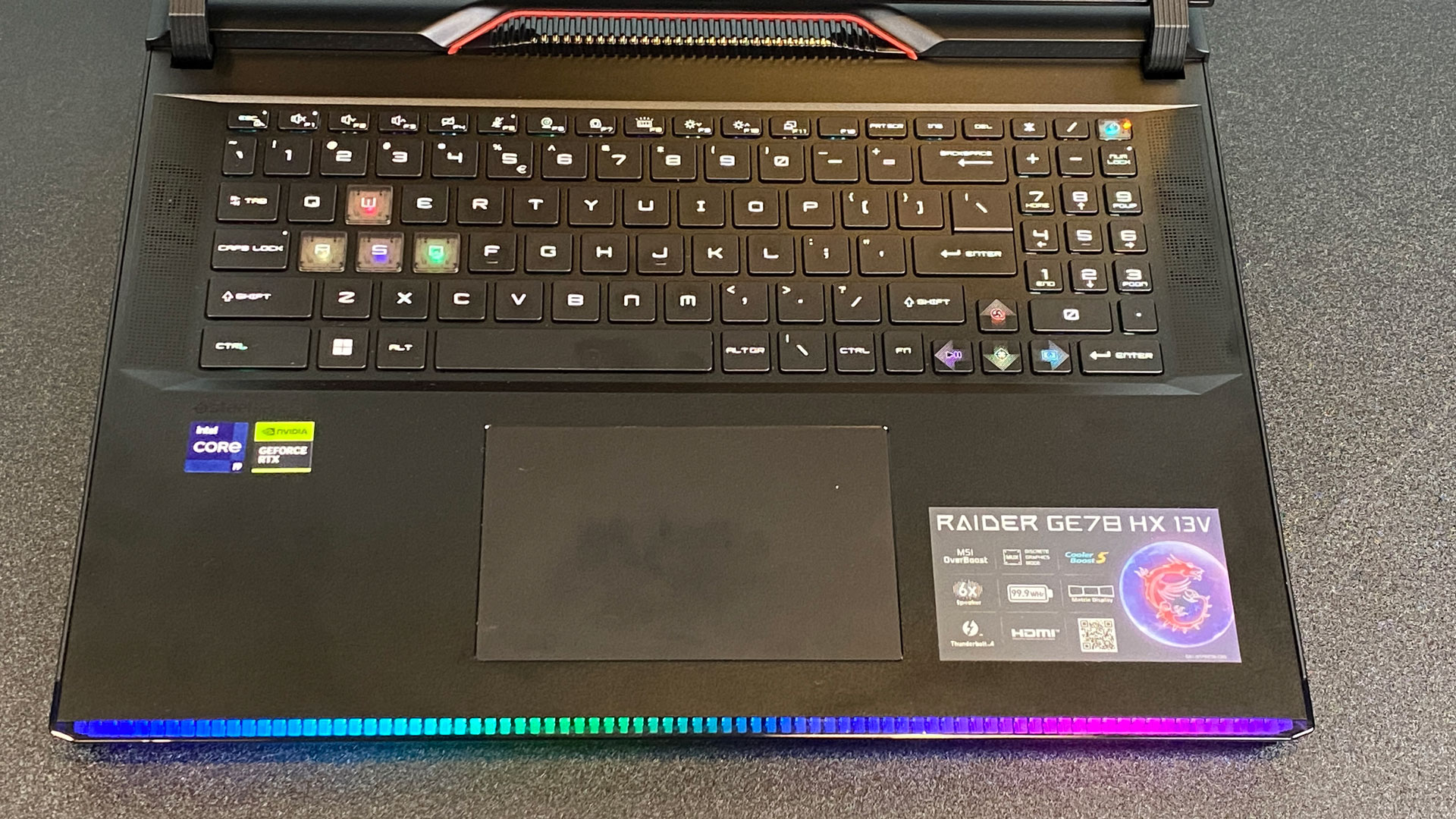
With this redesign, MSI is highlighting both sets of arrow keys. The WASD keys are clear, allowing more RGB lighting to show through. The arrow keys also serve as shortcuts to add a reticle to the screen, change fan speeds, play or pause media or turn off the touchpad. Behind those icons, the arrows are lit up by RGB. It's a cool effect, assuming you like the colorful backlighting.
My experience with the keys was good. They have linear travel, but come down with a thunk, and I appreciate that feedback. My only real issue was that the 5.1 x 3.2-inch touchpad is so tall that I had to reach further than expected onto the deck to actually type, which wasn't the most comfortable feeling. Still, on monkeytype, I hit 122 words per minute at 98% accuracy.
That giant touchpad, which takes advantage of the extra room from a taller screen, is smooth, responsive and feels solid when you click it. I had no issues with it, including with gestures, during testing. But the big touchpad and long deck mean you have to reach in further than you do on 16:9 laptops. I was halfway to my elbows to reach the top row — it was like having my fingers sit in the front row of a movie theatre, they were so close to the screen.
Audio on the MSI Raider GE78 HX
The Raider's speakers, which appear to spell out MSI, are potent. The two top-facing speakers and the four woofers did justice to Soundgarden's "Black Hole Sun," balancing Chris Cornell's crooning vocals with slow synths and wailing guitars. There's even some bass there, as well, and punchy drums on the low end. And the speakers get loud, easily filling a room before hitting 100% volume.
When I played Deathloop, I could hear faraway gunfire, which helped me decide which parts of levels to avoid. Music was clear, and my own weapons were plenty loud when it came time to fire them.
The pre-installed Nahimic software has a few profiles, like music (the default), movie and gaming. I used the sliders to increase the bass a bit, but I think most people will be satisfied without changing anything.
Upgradeability of the MSI Raider GE78 HX
To open the MSI Raider GE78 HX, you'll need to take out 13 Phillips head screws. One is hidden under a factory seal sticker, but there's no removing rubber feet, which is nice.
Prying the base off requires intense patience. I used a guitar pick-style tool to carefully work my way around the base. Loosening the clips was an exercise in frustration, including carefully getting in between the light bar and the bottom of the laptop. Eventually, it did come off, though I was surprised that it left a part above the laptop behind the hinge feeling loose.
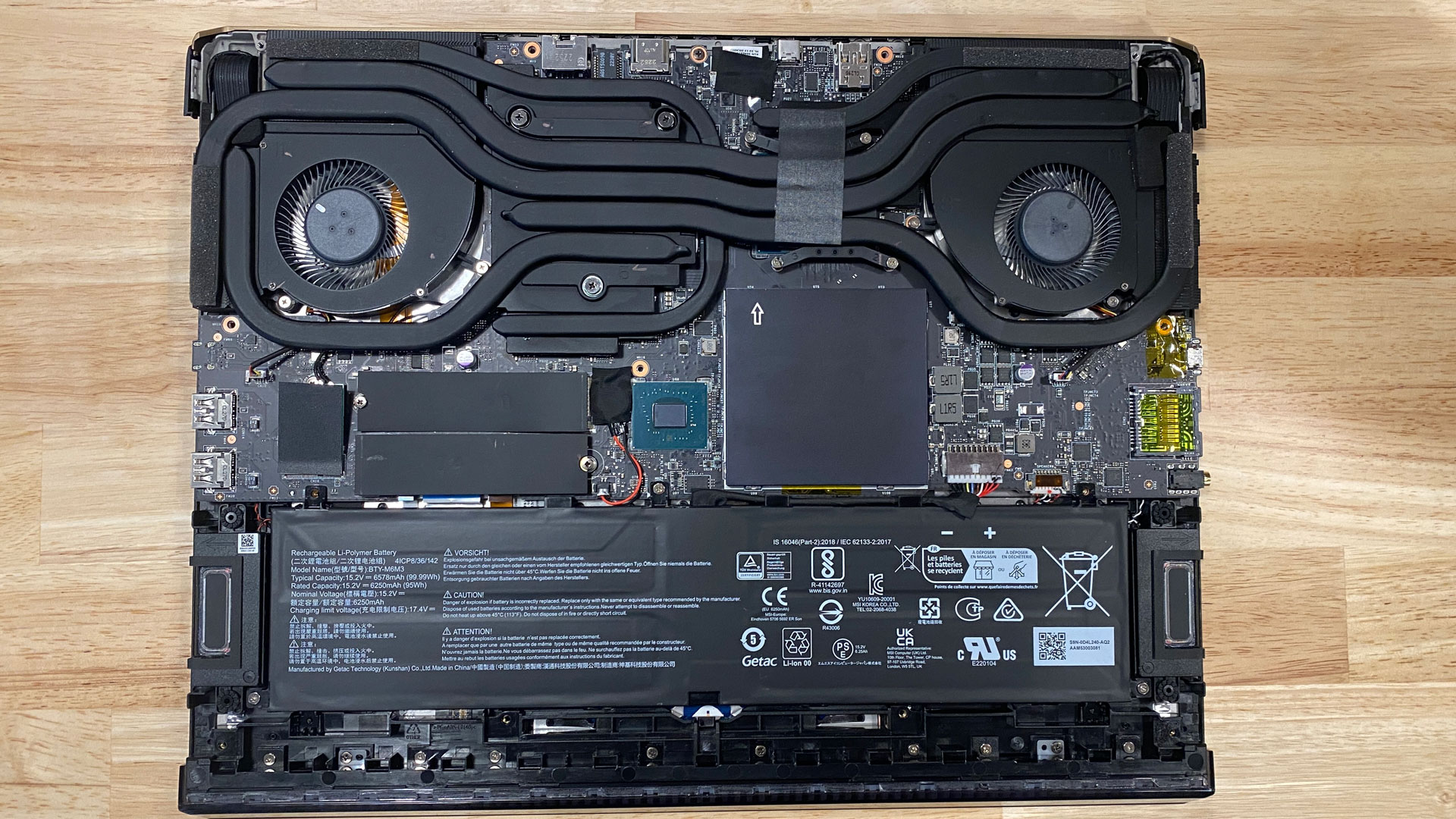
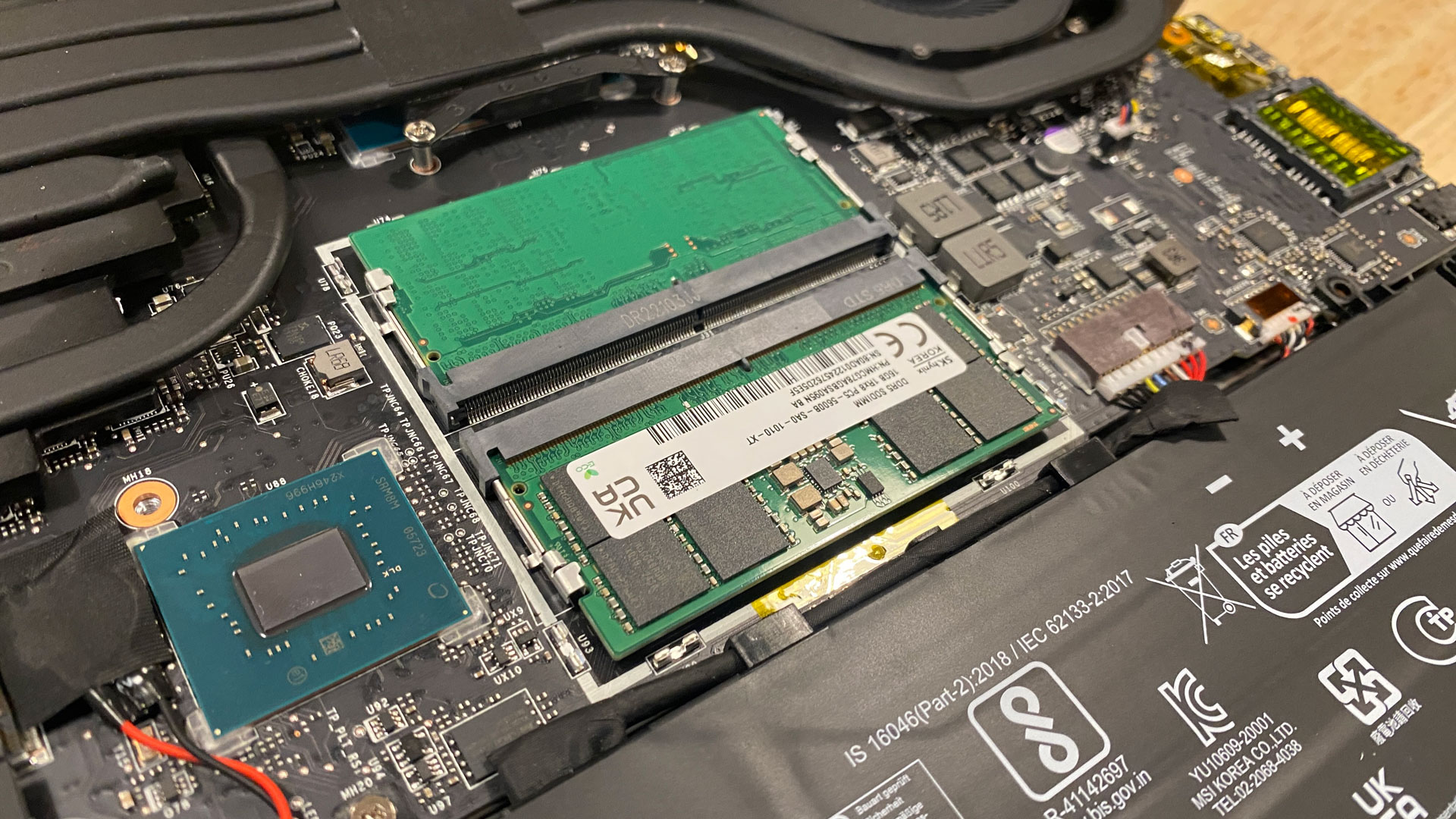
The upgrade options here are pretty standard for a gaming laptop. The Wi-Fi card, RAM, SSD and battery are all accessible. There's an extra SSD card slot (and some extra shielding for when you install it) on our unit, allowing you to expand your storage when you need it. The RAM, which is also under a shield, can also be easily swapped out.
Closing the laptop is its own headache. It took myself and a colleague working together to line up the bottom, which has to work its way over the hinge. Even then, the audio jack wasn't aligned right on the first try. So while you can upgrade this laptop, do it knowing you'll need to set some extra time aside.
Battery Life on the MSI Raider GE78 HX
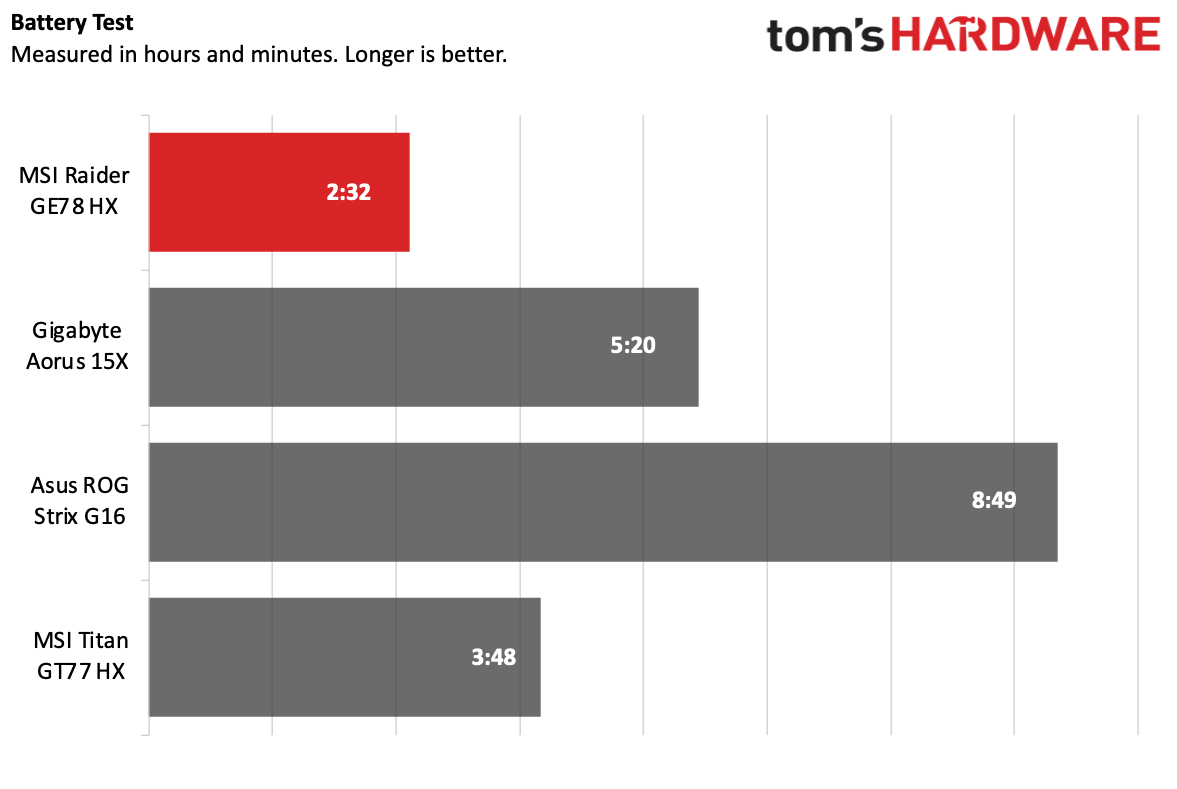
MSI's 99 WHr battery didn't prove to be long-lasting in our testing. The Raider only managed to browse the web, stream videos and run OpenGL tests with the screen at 150 nits of brightness for 2 hours and 32 minutes. That's the lowest of the group, with the Titan coming in at 3:58 and the Strix lasting a surprising 8:49.
Heat on the MSI Raider GE78 HX
When the Raider gets going, the fans run loud. Heck, sometimes they run that way at boot. But can those fans keep the system cool? To find out, we measured skin temperatures while running our Metro Exodus stress test.
At the center of the keyboard, between the G and H keys, it measured 37.6 degrees Celsius (99.68 Fahrenheit), which may get toasty after prolonged gameplay. The touchpad was cooler at 26.6 C (79.88 F), though for gaming you're best off using a mouse.
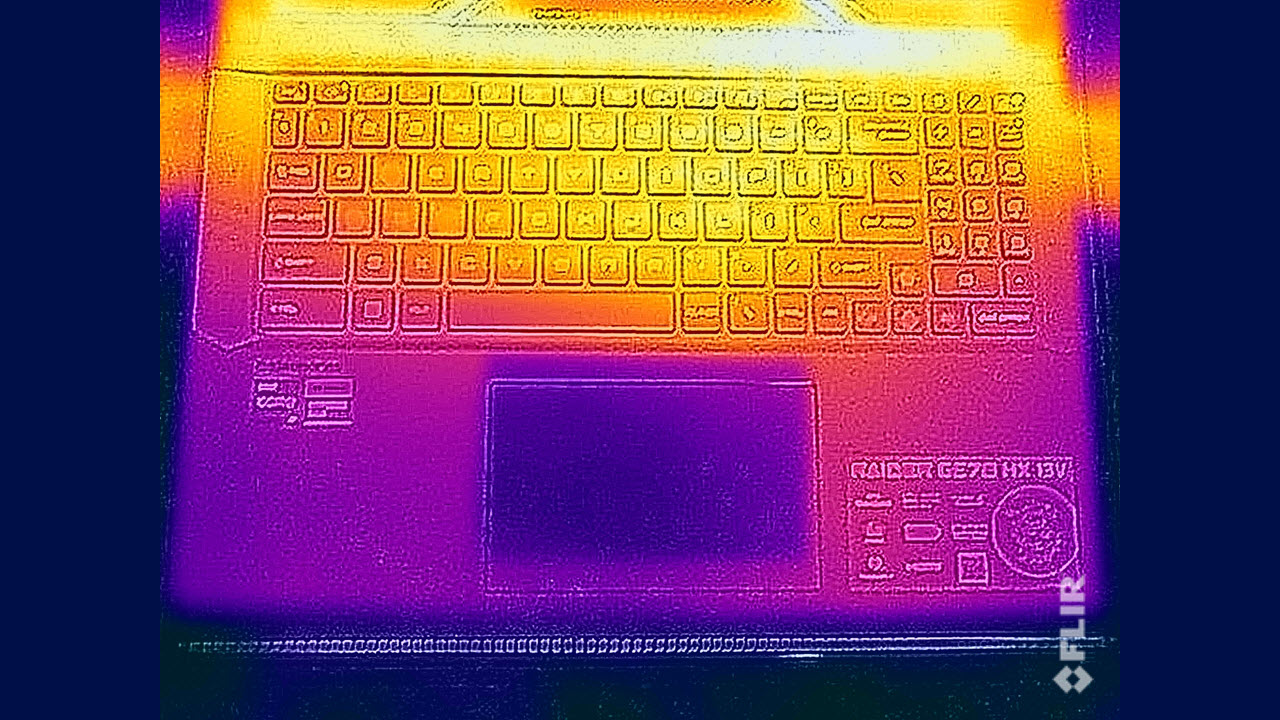
The hottest point on the bottom of the laptop measured 44.6 C (112.28 F), while another hotspot hit 43.5 C (110.3 F). These weren't by exhaust, but rather in line with where the cooling solution is.
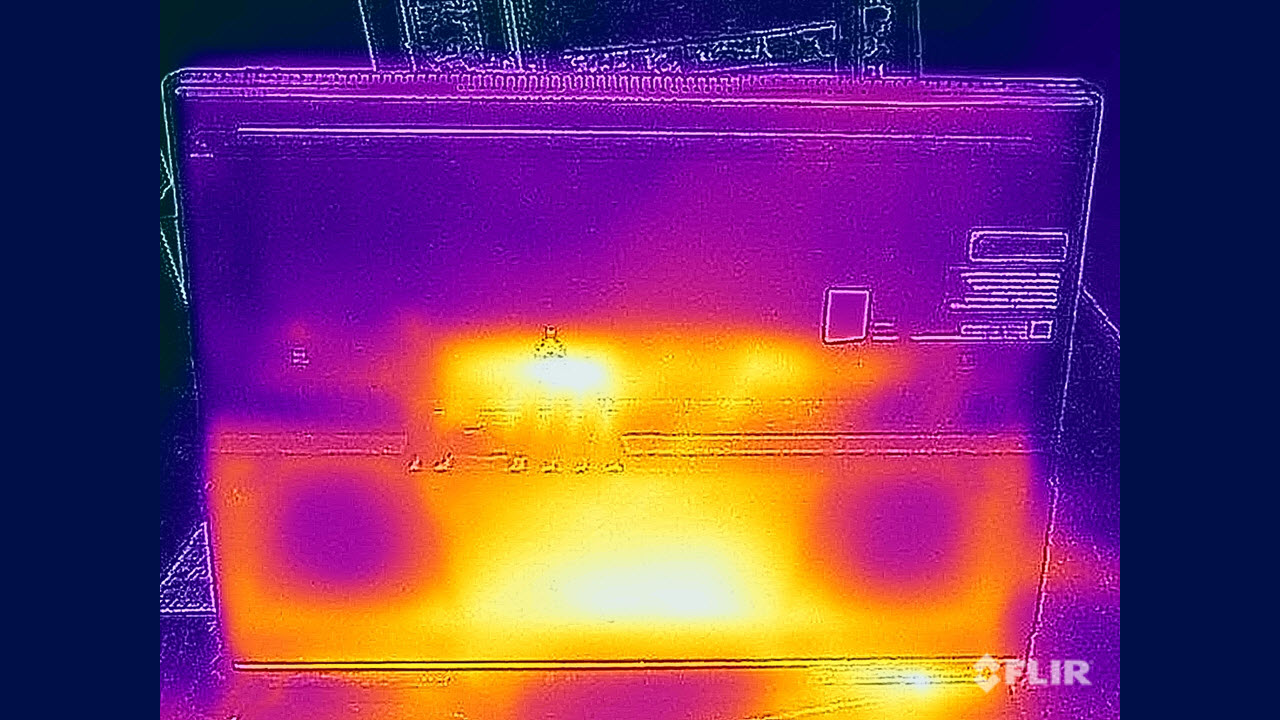
Webcam on the MSI Raider GE78 HX
The webcam on the Raider is a 1080p lens with an included privacy shutter. I don't see a ton of these shutters on gaming laptops, but it's an easy way to cover your camera without resorting to a sticker.
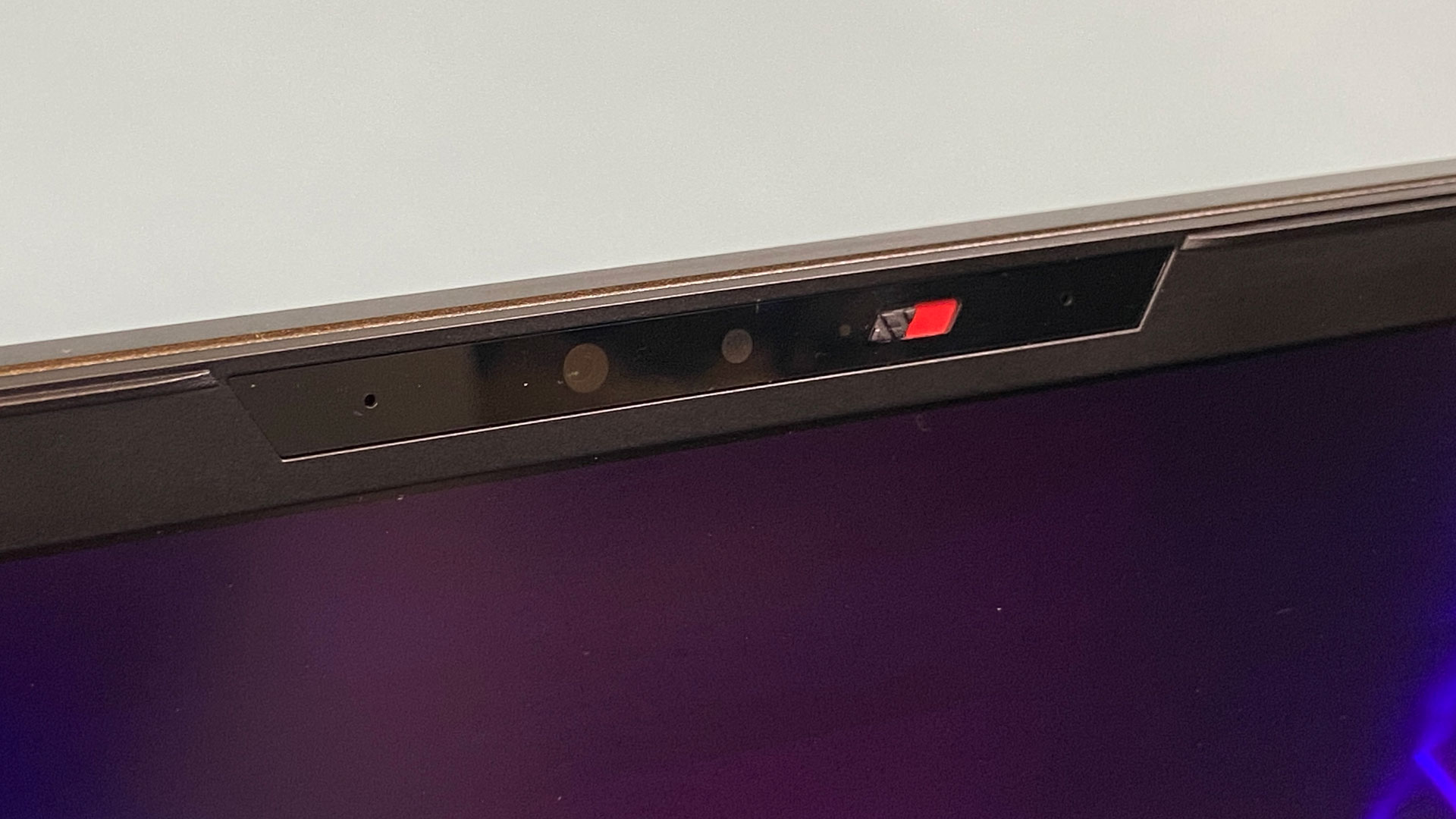
The standard camera works in conjunction with an IR camera to let you login with facial recognition using Windows Hello. In my experience, it let me log in quickly without issue.
The 1080p camera took detailed images and videos, showing off all of my hair and some developing wrinkles on my forehead. It was a bit dark, however, and my gray and blue shirt appeared to be almost in shadow.
Software and Warranty on the MSI Raider GE78 HX
There's no shortage of software preloaded on the Raider. The main app is MSI Center, which is supposed to be MSI's catch-all program for monitoring hardware status, grabbing serial numbers, switching power profiles and more. There are a number of optional modules to add, though the one I really wanted — Mystic Light to control RGB devices — kept failing to install.
Other MSI software includes True Color, to change screen temperature, toggle anti-blue light effects and switch to a movie mode, and MSI App Player, which lets you run Android apps in Windows (this seems wasteful when the Amazon Store is supported on Windows, though this does support the Play Store). Nahimic is on board for audio customization, while SteelSeries GG controls RGB on the keyboard and light bar.
Of course, there's a bunch of extra icons in the Windows Start menu, including WhatsApp, ESPN, Prime Video, TikTok and Instagram, which download when you click them.
MSI sells the Raider GE78HX with a 1-year warranty.
Configurations of the MSI Raider GE78 HX
We tested a $2,999.99 version of the MSI Rader GE78 HX with an Intel Core i9-13950HX, Nvidia RTX 4080 Laptop GPU, 32GB of RAM, 2TB of storage and a 17-inch, 240 Hz display. As of this writing, it's available at Micro Center, though the $2,9999 price is technically on sale. Micro Center originally had it listed at $3,299.99, but this sale price matches MSI's MSRP.
That's the cheapest version I saw. On MSI's site, a version identical to our review unit, but with a Core i9-13980HX 64GB of RAM, is $3,599.99 but out of stock, while a $4,000 option with an RTX 4090 and a Core i9-13980HX is also listed but not yet for sale (Amazon lists this version for $4,199, but actually has it in stock as of this writing).
Bottom Line
If you're looking for a gaming laptop that's powerful and just small enough to still be reasonably portable, the Raider GE78 HX is highly recommended. It offers strong performance, a bright display and plenty of ports, even if it gets kind of loud.
Those who want more power may want to consider going to even more premium laptops, like the Asus ROG Strix Scar 18 or MSI Titan GT77 HX, which are even larger and pack Nvidia's GeForce RTX 4090, though those get a pretty serious price bump. Those who want something a bit smaller could opt for Asus' ROG Strix G16, though that has less power as we reviewed it, a 720p webcam and far more limited display resolutions.
That makes MSI's 17-inch powerhouse solid on paper, but also in our testing. It's a potent performer with a beautiful display. But if you're going to put a new SSD in, bring lots of patience along with with your screwdriver.
MORE: How to Buy a Gaming Laptop
MORE: Best Gaming PCs







